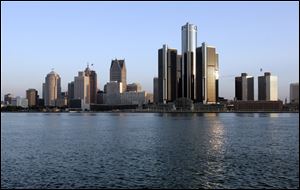
Detroit bankruptcy creditors’ vote being released
A year since city sought help, upgrades could factor into ruling
7/21/2014
In the little more than a year since state-appointed emergency manager Kevyn Orr made Detroit the largest U.S. city to seek bankruptcy protection, it has experienced a wide range of improvements that will factor into Judge Steven Rhodes’ decisions during next month’s bankruptcy trial.
DETROIT — Detroit neighborhoods are being relit, its vacant homes are being sold off or torn down, its public transportation is cleaner and more often on schedule, and the city has renegotiated some burdensome union contracts.
In the little more than a year since state-appointed emergency manager Kevyn Orr made Detroit the largest U.S. city to seek bankruptcy protection, it has experienced a wide range of improvements that will factor into Judge Steven Rhodes’ decisions during next month’s bankruptcy trial.
A major piece of the bankruptcy puzzle could fall into place today with the expected release of results of a vote by creditors, including more than 30,000 retired and current city workers, on whether to accept millions of dollars in cuts.
When Mr. Orr filed for bankruptcy, Detroit’s debt was estimated at $18 billion, and its revenue streams were too small to keep up with basic city services.
Since then, the city has installed at least 10,000 new streetlights.
It’s also going after absentee landlords — threatening to take and sell or demolish vacant houses that violate city codes. Eight houses awarded to the city’s Land Bank are being put up for auction.
Belle Isle, the city’s most popular public park, has been put under state control and received a much-needed cleaning.
Some of the most dramatic changes were designed to save the city money and didn’t need to wait for the August bankruptcy confirmation trial.
Mr. Orr has frozen some benefits for participants in the city’s two pension systems and ended the city’s defined contribution plan. Additionally, the city no longer provides health insurance to retirees.
Deals were reached with unions and retirees on a hybrid pension plan in which current, nonuniformed workers will contribute 4 percent of their salary toward benefits. Current police and firefighters will contribute 6 percent. New police and fire hires will chip in 8 percent of their base salary.
A coalition of 33 municipal unions, representing about 5,500 workers, also has banged out a five-year contract after nine months of negotiations with the city. It calls for wage increases of 5 percent this year and 2.5 percent hikes later.
“We’re going to show what we’ve done to date but also show more of what we need to do,” Orr spokesman Bill Nowling said, referring to the bankruptcy trial before Judge Rhodes.
The bankruptcy and fear of what could happen during the trial has steered many of the decisions, according to bankruptcy expert Doug Bernstein.
It has helped Detroit that Mr. Orr and his small army of lawyers and consultants are overseeing the bankruptcy, which allows Mayor Mike Duggan to figure out what needs to be improved on the street level, Mr. Bernstein added.
What’s going on now are improvements and right-sizing services to fit a population of about 700,000, rather than the 1.8 million Detroit was built to hold.
“For so long ... nobody wanted to change it. They just wanted to kick the can down the road,” Mr. Bernstein said.